Holly Thompson's Blog, page 4
September 30, 2020
My First Two Picture Book Translations
Over the past year, I've had the opportunity to work with Miyoshi Town (三芳町) Library in Saitama translating two picture books of local history. Thank you to Avery Fischer Udagawa (via JBBY) for sending this translation job my way!

Both books were created in conjunction with the town's Yomi-ai Read Together initiative:よみ愛・読書のまち, and I worked closely with librarian Tomoko Shirota throughout the translation, editing and copyediting process.
In June 2019, I visited Miyoshi Town to attend a performance of Chikumazawa Kuruma Ningyō puppetry by the local troupe and to gain some first-hand understanding of this performance art. Many people know of bunraku puppetry, but few are familiar with kuruma ningyō puppetry in which just a single puppeteer, seated on a small kuruma wheeled cart, controls each puppet.
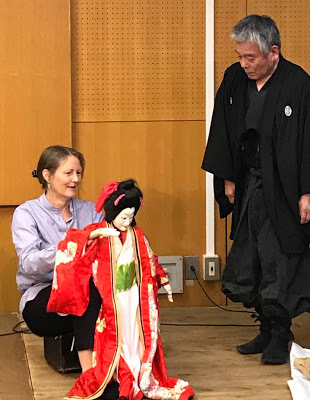
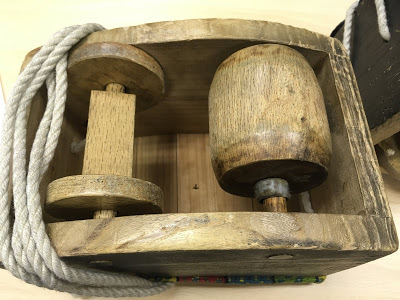
This puppetry style developed in the Tama region, and during the Meiji Era, the Maeda family of Chikumazawa began performances. However, as times changed and films and other forms of entertainment gained popularity, demand for puppet shows waned, and the last performance was held in 1921. Kuruma ningyō was put to rest, all but forgotten. Then in 1971, wicker boxes containing puppet parts, costumes, and carts were discovered in a Maeda family storeroom. Fortunately there were two healthy elderly individuals in the community who knew the art of kuruma ningyō puppetry and could train others. Now the Chikumazawa Ningyō Preservation Society troupe performs annually using original puppets, costumes and stories, and the performance art is taught to children in the region. This style of puppetry survives in just three places in Japan: Hachioji City, Okutama, and Chikumazawa in Miyoshi Town.
The picture book about this type of puppetry, かえってきた竹間沢車人形 (Kaettekita Chikumazawa kuruma ningyō; English title The Puppets Are Back! Chikumazawa Kuruma Ningyo Puppetry) written and illustrated by Noriko Sagesaka, is told from the vantage point of young Yoshiko who helps her father discover the puppets and follows along as he learns to manipulate the puppets and ultimately perform on stage. I was fortunate to meet the real Yoshiko and her father during my visit to Miyoshi Town!
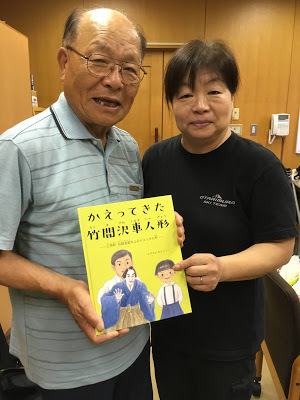
I loved the work of translating this book, especially the rich back matter and the interior "Look Inside!" and "Make It Move!" full-spread sections.
The second book おいしくなあれ富のいも(Oishiku naare tome no imo; English title Grow, Grow, Grow, Tome Sweet Potatoes!) by Hiromi Watanabe and illustrated by Hiroko Takai was actually the first book published in this reading initiative series. This book focuses on a type of sweet potato cultivated in the Kawagoe area of Saitama. During my visit to Miyoshi Town, I was able to visit the Santome Shinden fields--long rectangular land allotments created some 300 years ago combining space for farm houses, forest for leaf compost, and long fields for the sweet potatoes famous in this area. I was fortunate to meet the farmer of the story, which features a fictional grandson Daichi learning about the growing cycle and the traditional Edo-era method for creating satsuma-doko seed beds for temperature control.

In the story, Daichi plants his own seed potato in the fields, and in autumn during the fall harvest festival he savors the potatoes of his labor and looks forward to creating the seed bed again in early spring.
This book, too, is fiction that features child-friendly nonfiction elements: a full spread about the traditional leaf compost method, plus back matter about Miyoshi Town--home of the famous Tome sweet potatoes.
Miyoshi Town was selected to be an Olympic Host Town, and these books were translated anticipating an influx of tourists to the area this summer. Alas, COVID-19 interrupted those plans! At this time, the English-language translations are only available through special order via the Miyoshi Town Library. Librarians in Japan--PM me if you are interested in a copy!
As a picture book author, I love both crafting and reading fiction picture books that also weave in rich nonfiction contents. And I am always excited to work on projects about the arts, agriculture, rural life and nature. I hope to do more picture book translations in the future!
My First Two Picture Book Translations!
Over the past year, I've had the opportunity to work with Miyoshi Town (三芳町) Library in Saitama translating two picture books of local history. Thank you to Avery Fischer Udagawa (via JBBY) for sending this translation job my way!

Both books were created in conjunction with the town's Yomi-ai Read Together initiative:よみ愛・読書のまち, and I worked closely with librarian Tomoko Shirota throughout the translation, editing and copyediting process.
In June 2019, I visited Miyoshi Town to attend a performance of Chikumazawa Kuruma Ningyō puppetry by the local troupe and to gain some first-hand understanding of this performance art. Many people know of bunraku puppetry, but few are familiar with kuruma ningyō puppetry in which just a single puppeteer, seated on a small kuruma wheeled cart, controls each puppet.


This puppetry style developed in the Tama region, and during the Meiji Era, the Maeda family of Chikumazawa began performances. However, as times changed and films and other forms of entertainment gained popularity, demand for puppet shows waned, and the last performance was held in 1921. Kuruma ningyō was put to rest, all but forgotten. Then in 1971, wicker boxes containing puppet parts, costumes, and carts were discovered in a Maeda family storeroom. Fortunately there were two healthy elderly individuals in the community who knew the art of kuruma ningyō puppetry and could train others. Now the Chikumazawa Ningyō Preservation Society troupe performs annually using original puppets, costumes and stories, and the performance art is taught to children in the region. This style of puppetry survives in just three places in Japan: Hachioji City, Okutama, and Chikumazawa in Miyoshi Town.
The picture book about this type of puppetry, かえってきた竹間沢車人形 (Kaettekita Chikumazawa kuruma ningyō; English title The Puppets Are Back! Chikumazawa Kuruma Ningyo Puppetry) written and illustrated by Noriko Sagesaka, is told from the vantage point of young Yoshiko who helps her father discover the puppets and follows along as he learns to manipulate the puppets and ultimately perform on stage. I was fortunate to meet the real Yoshiko and her father during my visit to Miyoshi Town!

I loved the work of translating this book, especially the rich back matter and the interior "Look Inside!" and "Make It Move!" full-spread sections.
The second book おいしくなあれ富のいも(Oishiku naare tome no imo; English title Grow, Grow, Grow, Tome Sweet Potatoes!) by Hiromi Watanabe and illustrated by Hiroko Takai was actually the first book published in this reading initiative series. This book focuses on a type of sweet potato cultivated in the Kawagoe area of Saitama. During my visit to Miyoshi Town, I was able to visit the Santome Shinden fields--long rectangular land allotments created some 300 years ago combining space for farm houses, forest for leaf compost, and long fields for the sweet potatoes famous in this area. I was fortunate to meet the farmer of the story, which features a fictional grandson Daichi learning about the growing cycle and the traditional Edo-era method for creating satsuma-doko seed beds for temperature control.

In the story, Daichi plants his own seed potato in the fields, and in autumn during the fall harvest festival he savors the potatoes of his labor and looks forward to creating the seed bed again in early spring.
This book, too, is fiction that features child-friendly nonfiction elements: a full spread about the traditional leaf compost method, plus back matter about Miyoshi Town--home of the famous Tome sweet potatoes.
Miyoshi Town was selected to be an Olympic Host Town, and these books were translated anticipating an influx of tourists to the area this summer. Alas, COVID-19 interrupted those plans! At this time, the English-language translations are only available through special order via the Miyoshi Town Library. Librarians in Japan--PM me if you are interested in a copy!
As a picture book author, I love both crafting and reading fiction picture books that also weave in rich nonfiction contents. And I am always excited to work on projects about the arts, agriculture, rural life and nature. I hope to do more picture book translations in the future!
September 19, 2020
A Packed Week of American Lit
This week I taught my second Yokohama City University intensive course in two weeks. I usually teach American Literature/Literature in English over the course of fifteen weeks, five weeks of which is dedicated to literature circles for novels. This year, the course is offered as an intensive, so I revised the syllabus drastically to fit the one-week time frame and the remote delivery.
We focused on contemporary literature and read short stories by Sandra Cisneros, Arriel Vinson and Celeste Ng. We discussed the verse novel form and read a verse short story by Kip Wilson. We read an essay by Ona Gritz and narrative poems by Margarita Engle, Gary Soto, Naomi Shihab Nye, William Stafford, Li-Young Lee and Jacqueline Woodson. Students wrote reflections on the readings and a final report including analysis of additional stories, poems and essays.
Despite the time difference between Japan and Boston, we were so pleased to receive a Zoom visit from author Kip Wilson (author of the YA verse novel White Rose about anti-Nazi political activist Sophie Scholl). The students had read her verse story Car 393 about the Boston trolley accident of 1916, and we'd sent questions to Kip in advance. Thanks to Zoom, like magic she popped into our classroom Friday morning.
 How fortunate to have Kip chat with us and share the inspiration for crafting this Boston-set historical fiction story. She explained the research she conducted; her selection process for determining which particular individuals on the doomed trolley to feature as characters; her reasons for structuring the story in three parts with four voices; and her hopes that she has honored the individuals by painting them in a positive light via glimpses of their imagined hopes and dreams before the trolley plunged into the channel and a cold November rising tide.
How fortunate to have Kip chat with us and share the inspiration for crafting this Boston-set historical fiction story. She explained the research she conducted; her selection process for determining which particular individuals on the doomed trolley to feature as characters; her reasons for structuring the story in three parts with four voices; and her hopes that she has honored the individuals by painting them in a positive light via glimpses of their imagined hopes and dreams before the trolley plunged into the channel and a cold November rising tide.
Intensives offer students the opportunity to take a deep dive into a topic over a period of a week. The advantage is sustained focus from class to class. The downside is little or no time between each class for reading.
Several of my students joined both my Japanese Literature in English course and this American Literature course, for back-to-back deep dives. One of those students reflected that she hasn't read many books since starting university, but with these courses, she'd read stories and excerpts from various books--it was a good opportunity. Then she confessed to the class, "I'm afraid of reading books in English." And my breath caught when everyone nodded in agreement.
So we talked about the importance of finding books that interest you and feel right for your reading level, and the fact that tackling books above your level makes reading into a translation exercise. I pointed them toward middle grade and young adult novels, many of which are a perfect fit for Japanese university students.
So while I've loved these intensives, and the opportunities that the remote delivery opened up, maybe next year the course will be offered as a full semester course once again, and I can return to including novels and literature circles. How gratifying it always is to hear students say proudly, "This is the first novel I have read in English."
September 11, 2020
Teaching Japanese Literature in English
I finally received my re-entry permit to return to Japan in late August and completed my two weeks of self-quarantine just in time to start teaching my Yokohama City University courses. For the first time, I'm teaching Japanese Literature in English (in addition to creative writing, American lit and American culture courses), and this academic year, the course was scheduled as an intensive--15 weeks of class time crammed into five days. Times being what they are, we met remotely on Zoom.

I opted to focus on contemporary literature in this course. We started with translated flash fiction from the recent Tree-Novels "Day to Day" series for adults and "Story for You" series for children (middle-grade).
We read excerpts from The Beast Player by Nahoko Uehashi, translated by Cathy Hirano; My Brother's Husband by Gengoroh Takame, translated by Anne Ishii; GO by Kazuki Kaneshiro, translated by Takami Nieda (on Audible); Are You an Echo: The Lost Poetry of Misuzu Kaneko by David Jacobson, translated by Sally Ito and Michiko Tsuboi, illustrated by Toshikado Hajiri; Tokyo Ueno Station by Yu Miri, translated by Morgan Giles; Snow Bones by Masaya Saito; The Little House by Kyoko Nakajima, translated by Ginny Tapley Takemori; various short fiction and novel excerpts translated from Japanese in Words Without Borders including Breasts and Eggs by Mieko Kawakami, translated by Louise Heal Kawai; a passage from A True Novel by Minae Mizumura, translated by Juliet Winters Carpenter; another from Sachiko Kashiwaba; and more!
We also discussed the catalog of recommended children's and YA books prepared by the Japanese Board on Books for Young People. And we watched videos of author Nahoko Uehashi and translator Cathy Hirano speaking in the 2020 Printz Virtual Ceremony and translator Emily Balistrieri interviewed on NonNative Creative.
In our final class, students book talked literary works from Japan that they feel should be translated into English for world readers. They spoke of books they have loved and authors they admire.
And in the last hour, translator Ginny Tapley Takemori joined our Zoom session to answer questions pre-submitted by the students about her work on The Little House and translation in general. Question topics ranged from translator research of expressions, setting and historical content; translation of dialect; the #namethetranslator hashtag; and celebrity status for translators from English to Japanese in Japan, as opposed to virtual invisibility of translators of Japanese to English in other countries. Thank you for joining us, Ginny!
Here we are: Ginny Tapley Takemori bottom center with the English and Japanese editions of 小さいおうち (The Little House), me at the top with a handful of the books we discussed in class, and students showcasing the books they they strongly recommend for translation into English.

So, here's the list of student favorites:
しゃばけ (Shabake) yōkai series by 畠中 恵 (Hatakenaka, Megumi). Fiction for middle school students to adults.
ふしぎなかぎばあさん (Fushigina kagi bāsan--The Mysterious Key Grandma) by 手島 悠介 (Teshima Yūsuke). Novel series for children.
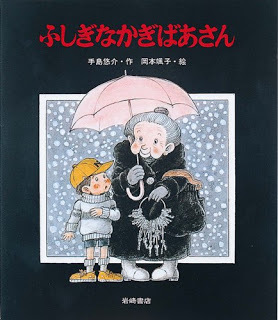
佐賀のがばいばあちゃん (Saga no gabai baachan--The Great Grandma of Saga) by 島田洋七( Shimada Yōshichi)Novel series for children.
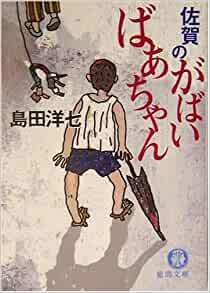
和菓子のアン(Wagashi no an--Wagashi Ann)by 坂木司(Sakaki Tsukasa). First book in a mystery series for adults.
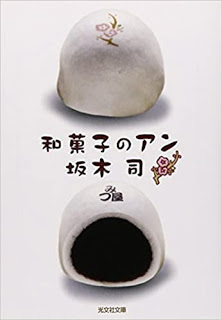
流浪の月(Rurou no tsuki--The Wandering Moon) by 凪良ゆう(Nagira Yū). Novel for adults.

きのう何食べた?(Kinou nani tabeta?--What did you eat yesterday?” byよしながふみ(Yoshinaga Fumi). Manga series for middles school and up.
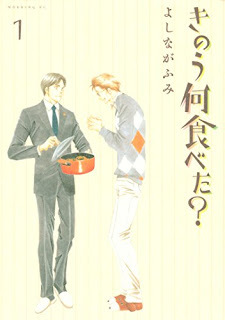
ジヴェルニーの食卓 (Jiveruni no shokutaku--Dinner Tables of Giverny) by 原田 マハ (Harada Maha). Historical fiction for adults.

もし文豪たちがカップ焼きそばの作り方を書いたら (Moshi bungōtachi ga kappu yakisoba no tsukurikata wo kaitara--If Literary Masters wrote Instructions for Making Cup Yakisoba) by 神田 桂一 (Kanda Keichi). Humorous fiction for adults.
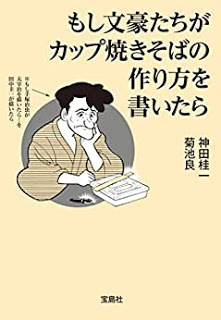
Thank you, students, for your diligent work this week and for these book recommendations!
May 21, 2020
This Day--a video poem
At that time, I'd encountered a series of traumas and jarring life disruptions, and this poem was one of my responses to the loss of control and fear I felt then, juxtaposed with moments of joy and hope. The poem seems fitting today during this coronavirus pandemic time, when so many aspects of our lives seem beyond our control.
Here you go: "This Day." May you hold close those moments of joy and hope.
May 1, 2020
30 Hope Poems: NPM 2020
When I began this challenge, I had little more than a list of the 30 species I'd decided to highlight. In other words, I hadn't pre-written these poems over previous weeks or months. Some days in April, I drafted several poems at once, other days I struggled with a single poem for hours. At the midway point, I doubted whether I could finish. But I pushed on and finished! In the process learned so much about the thirty species I featured, as well as delicate and threatened ecosystems in Massachusetts, and my poem writing process.
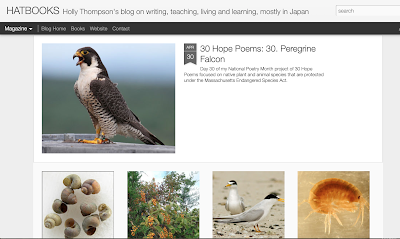
I urge everyone to discover the endangered and threatened species where you live or are sheltering. What can you learn about their behavior, life cycle and habitats? Why are they threatened? What can humans do to help them thrive? What are your hopes for those species? Try puzzling some words together into a poem for your own hope poems for endangered and threatened species.
Thank you to all of the organizations, including Mass Audubon, Essex County Greenbelt, Trustees of Reservations and MassWildlife that protect land and wildlife and provide educational opportunities for us to learn about our natural environments.
Here's the full List of links to my 30 Hope Poems 2020.
30. Peregrine Falcon
29. New England Siltsnail28. American Bittersweet
27. Least Tern26. Northern Spring Amphipod25. Water Shrew
24. Blue-spotted Salamander
23. Ski-tipped Emerald
22. Common Loon
21. Atlantic Sturgeon
20. Eastern Pondmussel
19. Eastern Meadowlark
18. Barrens Tiger Beetle
17. Kemp's Ridley Sea Turtle
16. American Bittern
15. American Bumble Bee
14. Great Laurel
13. Humpback Whale
12. Showy Lady's Slipper
11. Pied-billed Grebe10. Frosted Elfin 9. Britton’s Violet8. Little Brown Bat7. Eastern Box Turtle6. Short-eared Owl5. Foxtail Clubmoss4. Eastern Ratsnake3. Piping Plover2. Eastern Spadefoot1. Yellow Oak

Holly Thompson (www.hatbooks.com) is an author who lives in Japan but grew up in Massachusetts where she is now sheltering during the coronavirus pandemic, getting outside to walk and observe wildlife whenever she can.

April 30, 2020
30 Hope Poems: 30. Peregrine Falcon
Hopes for a Peregrine Falcon
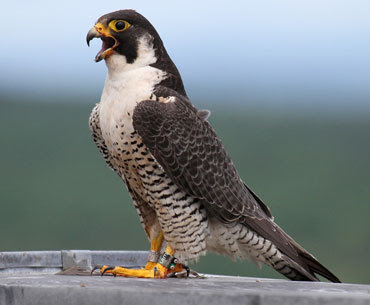 Peregrine Falcon (Image: U. Mass. Lowell)
Peregrine Falcon (Image: U. Mass. Lowell)
you are the fastest bird on earth,
the one who plunges in stoops
to stun unwitting birds passing below--
doves, starlings, grackles, jays
then performs an acrobatic feat
to loop back and snatch that body
as it plummets toward earth
to carry it back to your perch
you are the one who nests atop
urban buildings, shipyard cranes,
bell towers, rock ledges, bridges—
anywhere hospitable to your young
who’ll totter in their down and dine
on the feathers, meat and bones
you feed them until they are strong
enough for their first lone flights
toward earth where patrols of fans
observe on cameras and await
to help those who may fall, even
crash, to ensure that you thrive since
for years you’d teetered on the brink
of extinction, egg shells DDT weak
for decades your acrobatic plunges
had disappeared, a mere sky memory
yet you have triumphed, recovered,
returned to stun us all, giving hope
that more species, with assistance,
may survive the brink and thrive
©2020 Holly Thompson All rights reserved
The Peregrine Falcon (Falco peregrinus) is listed under the Massachusetts Endangered Species act as a species of Special Concern. See Peregrine Falcon in the Mass Wildlife’s Natural Heritage and Endangered Species Program. Check out these live peregrine falcon nest cameras in Massachusetts!
Write!What species are Endangered, Threatened or of Special Concern where you live? What information can you find about them? What hopes can you imagine for them? Challenge yourself and write your own set of hope poems for endangered and threatened species near you.
Why? Why write these hope poems? Writing a poem about a plant or animal is like making a sketch--it's a form of intense study and close attention--in this case, a study of endangered or threatened wildlife and their habitats wherever we live or are sheltering. To create a hope poem, we need to find empathy for the plant or animal, try to think from their perspective, then try to puzzle words together into a poem to convey hopes. A hope poem is a mindfulness exercise at this time when hope is something we all need.
These are my hope poems for #NationalPoetryMonth2020 so far:
30. Peregrine Falcon
29. New England Siltsnail28. American Bittersweet
27. Least Tern26. Northern Spring Amphipod25. Water Shrew
24. Blue-spotted Salamander
23. Ski-tipped Emerald
22. Common Loon
21. Atlantic Sturgeon
20. Eastern Pondmussel
19. Eastern Meadowlark
18. Barrens Tiger Beetle
17. Kemp's Ridley Sea Turtle
16. American Bittern
15. American Bumble Bee
14. Great Laurel
13. Humpback Whale
12. Showy Lady's Slipper
11. Pied-billed Grebe10. Frosted Elfin 9. Britton’s Violet8. Little Brown Bat7. Eastern Box Turtle6. Short-eared Owl5. Foxtail Clubmoss4. Eastern Ratsnake3. Piping Plover2. Eastern Spadefoot1. Yellow Oak
Holly Thompson (www.hatbooks.com) is an author who lives in Japan but grew up in Massachusetts where she is now sheltering during the coronavirus pandemic, getting outside to walk and observe wildlife whenever she can.

April 29, 2020
30 Hope Poems: 29. New England Siltsnail
Hopes for a New England Siltsnail
 American Siltsnail (jacksonvilleshells.org)
American Siltsnail (jacksonvilleshells.org)patienceon a mud bankbrings high tide, taste of brinealgae on your tongue till the tiderecedes
©2020 Holly Thompson All rights reserved
The New England Siltsnail (Floridobia winkleyi) is listed under the Massachusetts Endangered Species act as a species of Special Concern. See New England Siltsnail in the Mass Wildlife’s Natural Heritage and Endangered Species Program.
Write!What species are Endangered, Threatened or of Special Concern where you live? What information can you find about them? What hopes can you imagine for them? Challenge yourself and write your own set of hope poems for endangered and threatened species near you.
Why? Why write these hope poems? Writing a poem about a plant or animal is like making a sketch--it's a form of intense study and close attention--in this case, a study of endangered or threatened wildlife and their habitats wherever we live or are sheltering. To create a hope poem, we need to find empathy for the plant or animal, try to think from their perspective, then try to puzzle words together into a poem to convey hopes. A hope poem is a mindfulness exercise at this time when hope is something we all need.
These are my hope poems for #NationalPoetryMonth2020 so far:
29. New England Siltsnail28. American Bittersweet
27. Least Tern26. Northern Spring Amphipod25. Water Shrew
24. Blue-spotted Salamander
23. Ski-tipped Emerald
22. Common Loon
21. Atlantic Sturgeon
20. Eastern Pondmussel
19. Eastern Meadowlark
18. Barrens Tiger Beetle
17. Kemp's Ridley Sea Turtle
16. American Bittern
15. American Bumble Bee
14. Great Laurel
13. Humpback Whale
12. Showy Lady's Slipper
11. Pied-billed Grebe10. Frosted Elfin 9. Britton’s Violet8. Little Brown Bat7. Eastern Box Turtle6. Short-eared Owl5. Foxtail Clubmoss4. Eastern Ratsnake3. Piping Plover2. Eastern Spadefoot1. Yellow Oak
Holly Thompson (www.hatbooks.com) is an author who lives in Japan but grew up in Massachusetts where she is now sheltering during the coronavirus pandemic, getting outside to walk and observe wildlife whenever she can.

April 28, 2020
30 Hope Poems: 28. American Bittersweet
Hopes for American Bittersweet
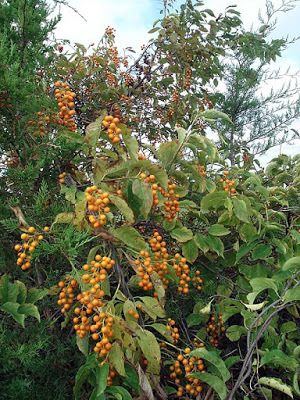 American Bittersweet (Wikimedia Commons)
American Bittersweet (Wikimedia Commons)slip away to twine through thicketsloop over fencerows and wind your vinesaround sapling trunks that your leavesmay reach toward woodland lightyour drooping clusters of fruit drawbirds to dine, dash and disperseyour seeds to increase your numbers
just slip away unseen by decoratorswreath-makers and greedy gathererslay your leaves over your berriesand forget to breathe as they passbe treasured and grown in nurseriesbe planted in backyard gardens thatyou may flourish once again in the wild
©2020 Holly Thompson All rights reserved
American Bittersweet (Celastrus scandens) is listed under the Massachusetts Endangered Species act as Threatened. Not to be confused with Celastrus orbiculatus, native to Japan, Korea and China, see Celastrus scandens, known as American Bittersweet, in the Mass Wildlife’s Natural Heritage and Endangered Species Program.
Write!What species are Endangered, Threatened or of Special Concern where you live? What information can you find about them? What hopes can you imagine for them? Challenge yourself and write your own set of hope poems for endangered and threatened species near you.
Why? Why write these hope poems? Writing a poem about a plant or animal is like making a sketch--it's a form of intense study and close attention--in this case, a study of endangered or threatened wildlife and their habitats wherever we live or are sheltering. To create a hope poem, we need to find empathy for the plant or animal, try to think from their perspective, then try to puzzle words together into a poem to convey hopes. A hope poem is a mindfulness exercise at this time when hope is something we all need.
These are my hope poems for #NationalPoetryMonth2020 so far:
28. American Bittersweet
27. Least Tern26. Northern Spring Amphipod25. Water Shrew
24. Blue-spotted Salamander
23. Ski-tipped Emerald
22. Common Loon
21. Atlantic Sturgeon
20. Eastern Pondmussel
19. Eastern Meadowlark
18. Barrens Tiger Beetle
17. Kemp's Ridley Sea Turtle
16. American Bittern
15. American Bumble Bee
14. Great Laurel
13. Humpback Whale
12. Showy Lady's Slipper
11. Pied-billed Grebe10. Frosted Elfin 9. Britton’s Violet8. Little Brown Bat7. Eastern Box Turtle6. Short-eared Owl5. Foxtail Clubmoss4. Eastern Ratsnake3. Piping Plover2. Eastern Spadefoot1. Yellow Oak
Holly Thompson (www.hatbooks.com) is an author who lives in Japan but grew up in Massachusetts where she is now sheltering during the coronavirus pandemic, getting outside to walk and observe wildlife whenever she can.

April 27, 2020
30 Hope Poems: 27. Least Tern
Hopes for a Least Tern
 Least Tern (image: US Fish & Wildlife Service)migration fatiguegets me down—find me a beachon the Atlantic where we can scrape out a neststay put and raise a few eggs
Least Tern (image: US Fish & Wildlife Service)migration fatiguegets me down—find me a beachon the Atlantic where we can scrape out a neststay put and raise a few eggsI know just the spotsandy site with ocean viewsherring schools nearbyfor me to catch and carryback to you and our new brood
©2020 Holly Thompson All rights reserved
The Least Tern (Sternula antillarum) is listed under the Massachusetts Endangered Species act as a species of Special Concern. See Least Tern in the Mass Wildlife’s Natural Heritage and Endangered Species Program.
Write!What species are Endangered, Threatened or of Special Concern where you live? What information can you find about them? What hopes can you imagine for them? Challenge yourself and write your own set of hope poems for endangered and threatened species near you.
Why? Why write these hope poems? Writing a poem about a plant or animal is like making a sketch--it's a form of intense study and close attention--in this case, a study of endangered or threatened wildlife and their habitats wherever we live or are sheltering. To create a hope poem, we need to find empathy for the plant or animal, try to think from their perspective, then try to puzzle words together into a poem to convey hopes. A hope poem is a mindfulness exercise at this time when hope is something we all need.
These are my hope poems for #NationalPoetryMonth2020 so far:
27. Least Tern26. Northern Spring Amphipod25. Water Shrew
24. Blue-spotted Salamander
23. Ski-tipped Emerald
22. Common Loon
21. Atlantic Sturgeon
20. Eastern Pondmussel
19. Eastern Meadowlark
18. Barrens Tiger Beetle
17. Kemp's Ridley Sea Turtle
16. American Bittern
15. American Bumble Bee
14. Great Laurel
13. Humpback Whale
12. Showy Lady's Slipper
11. Pied-billed Grebe10. Frosted Elfin 9. Britton’s Violet8. Little Brown Bat7. Eastern Box Turtle6. Short-eared Owl5. Foxtail Clubmoss4. Eastern Ratsnake3. Piping Plover2. Eastern Spadefoot1. Yellow Oak
Holly Thompson (www.hatbooks.com) is an author who lives in Japan but grew up in Massachusetts where she is now sheltering during the coronavirus pandemic, getting outside to walk and observe wildlife whenever she can.




